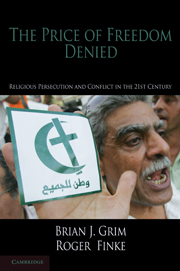Book contents
- Frontmatter
- Contents
- Preface:Religions' Shared Experience of Religious Persecution and Conflict
- 1 Religious Persecution
- 2 Religious Freedom
- 3 Persecution
- 4 Case Studies
- 5 A Closer Look
- 6 What about Muslim-Majority Countries?
- 7 Do Religious Freedoms Really Matter?
- Appendix Testing the Competing Arguments
- Bibliography
- Index
Appendix - Testing the Competing Arguments
Published online by Cambridge University Press: 05 June 2012
- Frontmatter
- Contents
- Preface:Religions' Shared Experience of Religious Persecution and Conflict
- 1 Religious Persecution
- 2 Religious Freedom
- 3 Persecution
- 4 Case Studies
- 5 A Closer Look
- 6 What about Muslim-Majority Countries?
- 7 Do Religious Freedoms Really Matter?
- Appendix Testing the Competing Arguments
- Bibliography
- Index
Summary
The statistical test we use – structural equation modeling – is not only appropriate for testing the competing arguments we have presented but it also provides a visual diagram of the relationships between the different measures we will describe. We hope that this will allow even statistical novices to visualize the argument and to see the strength of the relationships being tested. For those wanting more information on the models and the measures, please refer to our articles published in the American Sociological Review, the Interdisciplinary Journal of Research on Religion, and the JSM Proceedings, AAPOR-Section on Survey Research Methods, as well as the data at http://www.theARDA.com.
To test the full model we begin by simplifying the measures. Whereas Tables 3.1 and 3.2 in Chapter 3 reviewed eleven different items measuring various restrictions on religious freedoms, we reduce these multiple measures into two summary indexes, neither of which includes instances of religious persecution. In other words, the indexes include only restrictions and do not include acts of physical persecution. For our statistical analysis, the six items on government restrictions in Table 3.1 are combined into a single measure called the government restrictions index (GRI) and the five items in Table 3.2 are combined into a single measure called the social restrictions index (SRI). The GRI measures the restrictions placed on the practice, profession, or selection of religion by the official laws, policies, or administrative actions of the state, and the SRI measures the restrictions placed on religion by other religious groups, associations, or the culture at large.
- Type
- Chapter
- Information
- The Price of Freedom DeniedReligious Persecution and Conflict in the Twenty-First Century, pp. 215 - 222Publisher: Cambridge University PressPrint publication year: 2010



